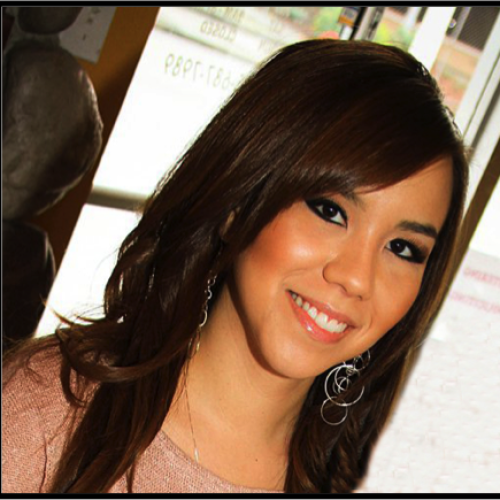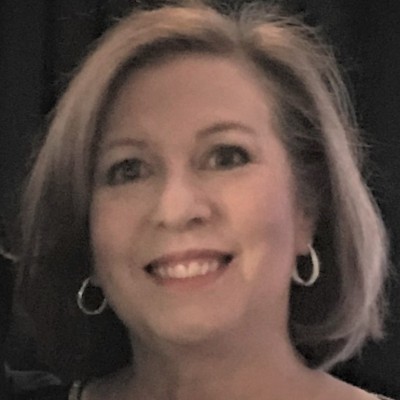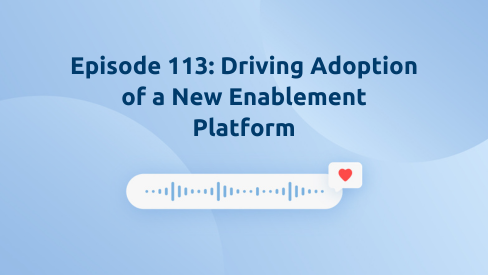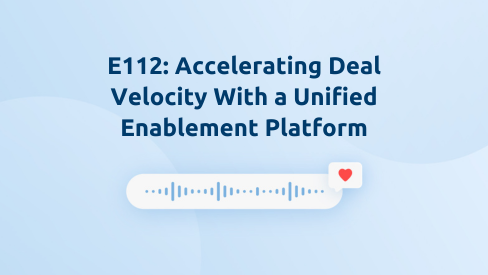According to research from Gartner, only 24% of workers have a high degree of readiness to adopt new technology. So how can you optimize your enablement tech stack to build excitement and drive adoption from the start?
Shawnna Sumaoang: Hi, and welcome to the Win-Win podcast. I’m your host, Shawnna Sumaoang. Join us as we dive into changing trends in the workplace and how to navigate them successfully.
Here to discuss this topic is Karen Gauthier, senior Manager of growth enablement at Bright Horizons. Thank you for joining us. Karen. I’d love for you to tell us about yourself, your background, and your role.
Karen Gauthier: Thank you for having me very much, Shawnna. I’ve been with Bright Horizons for about five years in sales enablement.
Our role here is basically to support our sales and client relations teams and serve up the right content, messaging and procedures so that they can do their job as effectively and scalable wise as possible. Prior to that, I worked in a number of different organizations, most recently education related.
And I started out doing technical and user documentation, writing, and then supporting the training of those documents with the user group. And it just kind of, you know, one thing led to another and I probably was doing enablement before they called it enablement, but here I am. So enjoy it very much.
SS: Well, we’re glad you’re here, Karen. Thank you for joining us. And given your extensive experience in education management, what are some of the. Unique challenges that reps in the industry face. And how would you say enablement can help them navigate these challenges?
KG: Yeah, well, specifically for Bright Horizons, we have a number of products and services that really run a span from onsite care through career development and college coach elder care, everything for the lifecycle of the workers of the employers that we support.
And so needing to understand all of the needs and the different types of tools that help. Those employers retain and recruit employees and just make it a quality place to work. And a best in class place to work is a big ask. So our reps not only need to understand the broad strokes, but the details and our job.
And I think that the job of enablement is to serve it up in bite-sized pieces, but not just content, but the context. So when given a specific. Situation, different client, different industry, all of the different regulations or legal or political things that are involved in, you know, care or working for a nonprofit, those types of things.
I mean, a lot of that makes our content very dependent on a specific use, and so having a tool that is robust, scalable, and flexible for our users with a good interface is a game changer.
SS: I love that. And your organization has evolved quite a bit. On the enablement front. You recently switched off a previous enablement platform and moved to Highspot.
Can you tell us a little bit more about some of the challenges your team faced before and how you’ve been able to overcome those since implementing Highspot?
KG: Sure. When I started with Bright Horizons, we were very new in the launch of that original tool, so we really did have it almost five years. I was there for kind of all of the growing pains, and I think that tool allowed us to understand what was available, what we could do.
But I feel like at some point. It hit its limits of growth and scalability and you know, then there are always the little support issues, upgrades and things like that, that we just felt like we were needing a little bit more. So we went ahead and really took a good long look at our requirements matrix and what we needed and did our due diligence and came upon Highspot as the best in class for our needs.
SS: I love that, and I think you made the right choice since you were a key advocate in the evaluation process. How did you build the business case for switching to a new enablement platform, and how did you go about securing stakeholder buy-in?
KG: Yeah, I think that the first thing that we’ve tried to do that I think we learned using the original tool that we had was we had kind of sporadically throughout our user base, some key users that were early adopters and leaders on their teams, and we just kept them very closely in the loop as kind of team members.
Tangentially so that they, they would be aware of what was going on. They could provide us feedback, what was working, what wasn’t, and using them as a sounding board, we were able to identify very quickly, not only what requirements we needed to kind of improve on with a new tool, but also prioritize them.
And so being able to use that as our main business case. As our internal customers. Then when we went to the management, you know, ladder as we need to make a change and within our scope of budget, these are the priorities over the next three, six months and then a year and further, we were able to kind of take that scope of what we needed and the budget and the sale, and then having an internal coach and champion.
Helped us navigate some of the internal procurement and technology things that needed to be tied together. So just kind of bringing everyone into the organization of understanding what needed to happen and prioritizing it was the most important thing for us.
SS: Well, you must have done a phenomenal job on that front.
The team did. Yeah. Team effort. Now, at your previous company, you participated in the implementation of Highspot. In your opinion, what are the key building blocks for a successful rollout of a new platform?
KG: I mean, I think one of the biggest mistakes, and this goes back to my training and documentation days, is not stepping into the user’s day in the life.
And, you know, there could be a hundred features in, in a particular tool, but they may use five of them 90% of the time. And so it, it’s a matter of really stepping into their shoes and understanding what needs to get done, what needs to get done at scale, what are some nuances. For the different ways their days could go and then incorporate that into the rollout prioritization plan.
And, and that was something that part of the team I was on at a previous company did a really good job. And then, you know, kind of accepted all support from people that were willing to help in, in identifying little details of things that could go wrong down the road, not just the big picture, but. The little details, like there’s embedded links that are gonna go wrong in a script when that old tool goes away.
And just identifying a lot of that stuff up front so you don’t have chaos day one.
SS: Yeah. Well, I have to say your approach to stepping into their shoes must be working because you’ve already seen an impressive 85% recurring usage of Highspot. So I’d love to understand what are some of your best practices for driving adoption and really building excitement for your programs amongst the teams that you support?
KG: Well, thank you for that. Our teams worked really hard, like I said, to have champions throughout the user base. We have users in the US separately in the UK, and then we have three different main lines of business. So it’s kind of spread out and all of them have unique needs, and so making sure that we bring them in so that not only do they feel part of the solution, but they can then go back and be champions and socialize it with their teams and, and we started that early on for this implementation.
For a number of reasons. We had a very, very tight rollout. It was like five weeks, and so that was like all hands on deck. And the goal on the backend was just to kind of drill in, get as much done as we could, but outwardly we just kind of dripped out information, made it as positive as possible. And then I think the key to the adoption being successful was on day one, there were very few things that they used to do that they couldn’t still do.
So that was priority one, was to kind of keep it. Status quo. And then once all the little bugs were worked out, then we started, you know, bringing out some of the features that we knew were very, very high on the priority list. And, the other thing we did was have a lot of opportunities for them to jump in as questions offered one-on-ones, jumped in on team calls, provided our own little videos and job aids for people, that kind of thing.
Just so that there were a lot of communication tools out there so that they felt like they were always kind of having it in the forefront and, oh, I can do this, I can do that, and that seemed to just feed on itself and work well.
SS: Amazing. Well, like I said, phenomenal job already. That is amazing. Now, as we head it into this year, I know one area that you plan on focusing on is enhancing buyer engagement.
Can you share how you envision leveraging features like digital rooms to personalize and elevate the buyer journey?
KG: That was one of the main tools, I think when we were out in the market looking for something to elevate our users into. That context was not just, you know, serving up the right brief at the right time because it’s the healthcare industry, but as part of a buyer journey.
What pieces during an introductory BDR conversation would be more useful than like right before a finalist meeting. And so that was something that because we have a lot of deals going on concurrently, we wanted to be able to have something that we had a template for that could be reused, but also customizable with a pretty.
Easy interface so that our users could make those changes. And it didn’t have to be gate kept by the admin group. So that was phase one was just kind of understanding that people were used to just dropping something in an email and sending it out, and we were losing not only the ability to repeat it, but we can track.
Any of the information that was now available to us in engagements and we couldn’t relate it to opportunities, accounts, contacts in Salesforce and gain information that way. So we started out just really getting people used to the email pitches and link pitches so that they were getting a little more familiar with internally.
In the tool, sending things out to prospects and clients, and that went really well. So then our new launch, which is something we’re working on now, we are, we have a few prototypes of some different digital sales rooms, and the initial feedback has been very positive. We’re hearing that they’re able to connect with people that had gone silent or share things and the response from their prospects has been that they like having one portal, that they know that information’s gonna get updated or the next time they go, if there’s an updated version, it’s gonna be there. And it’s been so far, very, very successful. We’re excited to expand it further, but I feel like just being three, four months into our launch of Highspot and being this far, being able to actually get this out there has been a big win.
We’re excited about that.
SS: Amazing. You touched on this a little bit, but I know you’re currently working on integrating Salesforce with Highspot. What value do you see in this integration and what outcomes are you hoping to achieve?
KG: Well, I think because we don’t have one path to a sale or one path to a existing client, so I think right now we’re just kind of getting a feel for.
What that data’s gonna look like when it comes in. I mean, we know theoretically what it’s gonna do, but right now we’re making sure that whenever somebody shares something externally or uses a digital sales room that they’re relating so that we can start gathering all of the engagement information, tie it back to Salesforce, and we’re hoping to see is which content is most useful, at which stages of the lifecycle of a deal, which pieces of content help push it?
Further and are there gaps where there just wasn’t content at the right stage for the right type of deal so that we can be serving up the right content at the right time. So I think initially that’s, that’s what we hope to get is providing the right content and then later making sure that we can tighten up our sales playbook with what to use at the right time throughout the lifecycle.
Some of our deals are very short, but you know, building a new center is months and months, so they’re very different.
SS: It’s amazing though that you guys are using that integration and that data that you’re seeing to really understand the full buyer’s lifecycle, so that’s phenomenal. Since launching Highspot, I’d love to understand what results you’ve seen so far and are there any key wins or notable business outcomes you can share with us yet?
KG: I don’t have anything very quantitative. I can just say that whatever we are receiving in terms of information about what people are viewing and which tools are which, which pieces of content are more receptive than others, that’s all a hundred percent in improvement over where we were before. Because some information’s better than no information.
I think. The people that use it appreciate the ability to go in and make it theirs, but not have to start from scratch. I think they like the idea of being able to see the metrics of people’s use or lack of use, and then understanding there’s another way to go about reaching out to that person. People you know that have different comfort levels with technology. So, you know, some people are gonna be all in on just building this out internally in the tool. Some people are gonna wanna just grab a link and put it in an Outlook email, and their clients might be appreciative of one way and not another. So I think that was one of the big wins we found so far, is that the tool is flexible enough to give and take for what we need.
SS: Amazing. Well, Karen, we’re excited that you’re on this journey with us. And now I will say, last question for you, if you don’t mind. For enablement leaders looking to effectively implement and drive adoption for their new enablement platform, what is maybe the biggest takeaway you’d leave them with?
KG: I think you need to know your customer, which is the internal users, and I think that you just have to find the tool that matches as best you can, given your budget and then prioritize.
You can’t boil the ocean, but you know, you can pick and choose and and get those wins and, and when you do get a good win at an early win, good news travels fast, and when the right people hear the right message, it just does build on the energy, which is. Very helpful for the new tools that we wanna bring out to them.
Things like the AI, we’ve just started dipping our toe into what that can do for us, and being able to get those wins with your user base behind you allows you to have the flexibility to play with some of the new features and bring them more.
SS: Amazing. Well, Karen, thank you so much for joining us. I really appreciate it.
KG: My pleasure. Thanks for having me.
SS: To our audience, thank you for listening to this episode of the Win-Win podcast. Be sure to tune in next time for more insights on how you can maximize enablement success with Highspot.



